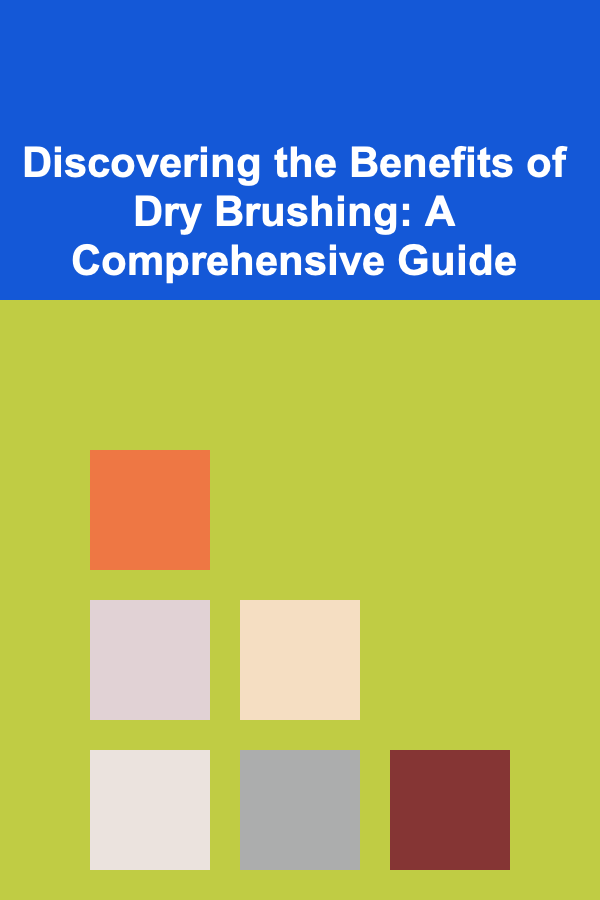
Discovering the Benefits of Dry Brushing: A Comprehensive Guide
ebook include PDF & Audio bundle (Micro Guide)
$12.99$8.99
Limited Time Offer! Order within the next:

Dry brushing, an ancient practice rooted in Ayurveda and other traditional healing systems, has experienced a surge in popularity in recent years. It's a simple yet potentially powerful self-care ritual that involves brushing the skin with a dry, natural-bristled brush, typically before showering. While not a replacement for medical treatment, dry brushing offers a range of potential benefits, from exfoliation and lymphatic support to improved circulation and stress reduction. This comprehensive guide delves into the science, techniques, and considerations surrounding dry brushing, providing you with the knowledge to determine if it's a suitable addition to your wellness routine.
The History and Origins of Dry Brushing
The practice of dry brushing isn't new. Its roots can be traced back centuries, with variations appearing in different cultures around the world. In Ayurveda, the traditional Indian system of medicine, dry brushing (known as garshana) is a core component of detoxification practices. The goal is to stimulate the lymphatic system and remove ama (toxic buildup) from the body. Similar techniques were used in ancient Roman and Greek cultures, often involving scraping the skin with metal or ceramic tools to exfoliate and invigorate.
Over time, these practices evolved, and the use of natural-bristled brushes became more common. Today, dry brushing is enjoying a revival, fueled by growing interest in natural health and wellness. Modern practitioners emphasize the potential benefits for skin health, detoxification, and overall vitality.
Understanding the Science Behind Dry Brushing
While anecdotal evidence and traditional practices support the benefits of dry brushing, it's important to understand the scientific basis for these claims. Here's a breakdown of the key physiological mechanisms potentially involved:
1. Exfoliation and Skin Health
One of the most immediate and noticeable effects of dry brushing is exfoliation. The bristles of the brush gently remove dead skin cells from the surface of the skin, revealing smoother, brighter skin underneath. This exfoliation process can:
- Improve skin texture and tone.
- Reduce the appearance of fine lines and wrinkles.
- Unclog pores, potentially preventing acne and ingrown hairs.
- Enhance the absorption of moisturizers and other skincare products.
The skin is the body's largest organ and plays a crucial role in protecting us from the external environment. Regular exfoliation through dry brushing helps maintain its health and function.
2. Lymphatic System Stimulation
The lymphatic system is a network of vessels and tissues that plays a vital role in immune function and waste removal. It collects excess fluid, toxins, and cellular debris from the body's tissues and transports them to the lymph nodes, where they are filtered and neutralized. Unlike the circulatory system, which has the heart to pump blood, the lymphatic system relies on movement and muscle contractions to circulate lymph fluid.
Advocates of dry brushing believe that it can stimulate the lymphatic system, promoting detoxification and reducing fluid retention. The gentle pressure and rhythmic movements of the brush are thought to encourage lymphatic drainage, helping the body eliminate waste products more efficiently. While research on the direct effects of dry brushing on the lymphatic system is limited, studies have shown that massage and other forms of manual lymphatic drainage can improve lymphatic flow. It's hypothesized that dry brushing provides a similar, albeit milder, form of stimulation.
3. Improved Circulation
Dry brushing can also improve circulation by stimulating blood flow to the surface of the skin. The act of brushing creates friction and pressure, which encourages blood vessels to dilate, increasing blood flow to the treated area. This improved circulation can:
- Deliver more oxygen and nutrients to skin cells.
- Promote collagen production, contributing to skin elasticity and firmness.
- Help reduce the appearance of cellulite (though this is often temporary).
- Create a feeling of warmth and invigoration.
While the increase in circulation may be localized to the skin, it can contribute to a feeling of overall well-being.
4. Nervous System Stimulation and Stress Reduction
The skin is densely populated with nerve endings, making it highly sensitive to touch. Dry brushing can stimulate these nerve endings, creating a mild sensory experience that can be both invigorating and relaxing. Some people find that dry brushing helps to:
- Reduce stress and anxiety.
- Improve energy levels and alertness.
- Promote a sense of grounding and connection to the body.
The gentle, rhythmic movements of the brush can have a calming effect on the nervous system, similar to the benefits of massage or mindful touch.
Choosing the Right Dry Brush
Selecting the right dry brush is essential for maximizing benefits and avoiding skin irritation. Here's what to look for:
- Natural Bristles: Opt for a brush with natural bristles, such as those made from plant fibers (e.g., agave or sisal) or animal hair (e.g., boar bristles). Natural bristles are generally less abrasive than synthetic bristles and are more effective at exfoliating the skin.
- Firmness: Choose a bristle firmness that suits your skin type and sensitivity. If you have sensitive skin, start with a softer brush and gradually increase the firmness as your skin becomes accustomed to the treatment.
- Handle Length: A long handle is ideal for reaching areas like the back and legs. A shorter handle may be preferred for smaller areas like the arms and chest.
- Shape: Brushes come in various shapes, including round, oval, and rectangular. Choose a shape that feels comfortable and allows you to easily reach all areas of your body.
- Quality: Invest in a high-quality brush that is well-made and durable. A good brush should last for several months with proper care.
Avoid brushes with synthetic bristles, as they can be too harsh and irritating for the skin. Look for brushes specifically designed for dry brushing, as they are typically made with the appropriate bristle firmness and handle length.
The Dry Brushing Technique: A Step-by-Step Guide
Proper technique is crucial for maximizing the benefits of dry brushing and minimizing the risk of skin irritation. Follow these steps for a safe and effective dry brushing experience:
- Choose a Time: The best time to dry brush is before showering, as this allows you to wash away any dead skin cells and toxins that are released during the process.
- Prepare Your Skin: Ensure your skin is dry and free of lotions, oils, or other products.
- Start at the Feet: Begin at your feet and brush upwards towards your heart, using long, sweeping strokes. The direction of brushing is important for promoting lymphatic drainage.
- Brush Each Area Several Times: Brush each area of your body several times, overlapping your strokes slightly. Apply gentle but firm pressure. The skin should be stimulated but not irritated.
- Move Up the Body: Continue brushing up your legs, then your arms, always moving towards your heart.
- Brush Your Stomach and Back: When brushing your stomach and back, use circular motions. Be particularly gentle on sensitive areas like the chest and breasts.
- Avoid Sensitive Areas: Avoid brushing areas with broken skin, rashes, or inflammation. Also, avoid brushing your face unless you have a brush specifically designed for facial dry brushing.
- Shower After Brushing: After dry brushing, take a shower to remove any dead skin cells and toxins that have been released.
- Moisturize Your Skin: After showering, apply a natural moisturizer to your skin to keep it hydrated and nourished.
- Clean Your Brush: Clean your dry brush regularly with soap and water to prevent the buildup of bacteria. Allow the brush to dry completely before using it again.
Important Considerations:
- Pressure: Use gentle but firm pressure. The goal is to stimulate the skin, not to scrub it raw.
- Stroke Direction: Always brush towards your heart to promote lymphatic drainage.
- Duration: Start with 5-10 minutes of dry brushing per session and gradually increase the duration as your skin becomes accustomed to the treatment.
- Frequency: Dry brush 2-3 times per week to start and gradually increase the frequency to daily if desired.
- Listen to Your Body: If you experience any irritation, redness, or discomfort, reduce the pressure or frequency of dry brushing.
Potential Benefits of Dry Brushing: A Deeper Dive
While we've touched upon the potential benefits of dry brushing, let's explore them in more detail:
1. Cellulite Reduction (Temporary Improvement)
One of the most commonly cited benefits of dry brushing is cellulite reduction. Cellulite is a common condition that affects many women, causing dimpled or lumpy skin on the thighs, buttocks, and other areas. While dry brushing won't eliminate cellulite completely, it can temporarily improve its appearance by:
- Improving circulation to the affected area.
- Breaking down fat deposits beneath the skin.
- Stimulating collagen production.
The improvement in cellulite appearance is often temporary, but regular dry brushing can help maintain the results. Combining dry brushing with other cellulite-reducing strategies, such as exercise and a healthy diet, may provide more significant and long-lasting benefits.
2. Improved Digestion and Gut Health (Indirectly)
While dry brushing doesn't directly affect the digestive system, it can indirectly contribute to improved digestion and gut health by:
- Reducing stress and anxiety, which can negatively impact digestion.
- Stimulating the lymphatic system, which helps remove waste products from the body.
- Promoting overall well-being, which can positively influence gut health.
A healthy gut microbiome is essential for proper digestion and nutrient absorption. By promoting overall well-being, dry brushing can contribute to a healthier gut environment.
3. Enhanced Immune Function (Lymphatic Support)
As mentioned earlier, dry brushing is believed to stimulate the lymphatic system, which plays a crucial role in immune function. The lymphatic system helps remove toxins, bacteria, and viruses from the body, preventing them from accumulating and causing illness. By promoting lymphatic drainage, dry brushing may help:
- Strengthen the immune system.
- Reduce inflammation.
- Improve the body's ability to fight off infections.
Maintaining a healthy lymphatic system is essential for optimal immune function. While more research is needed to confirm the direct effects of dry brushing on the lymphatic system, anecdotal evidence suggests that it can be a valuable tool for supporting immune health.
4. Increased Energy Levels and Reduced Fatigue
Many people report feeling more energized and less fatigued after dry brushing. This may be due to:
- Improved circulation, which delivers more oxygen and nutrients to the cells.
- Stimulation of the nervous system, which can increase alertness and energy levels.
- Stress reduction, which can reduce fatigue and improve overall well-being.
If you're feeling sluggish or tired, dry brushing may provide a natural and invigorating boost of energy.
5. Stress Relief and Relaxation
The gentle, rhythmic movements of dry brushing can have a calming effect on the nervous system, promoting relaxation and reducing stress. The act of self-care can also be incredibly therapeutic. Taking a few minutes each day to focus on your body and practice mindfulness can help reduce stress and improve your overall mental well-being.
Who Should Avoid Dry Brushing?
While dry brushing is generally safe for most people, there are certain situations where it should be avoided or approached with caution:
- Skin Conditions: Avoid dry brushing if you have eczema, psoriasis, rosacea, or other inflammatory skin conditions. The brushing can irritate the skin and worsen these conditions.
- Open Wounds or Sores: Do not dry brush over open wounds, cuts, or sores.
- Sunburn: Avoid dry brushing sunburned skin, as it can further irritate the skin.
- Sensitive Skin: If you have very sensitive skin, start with a very soft brush and brush very gently. Monitor your skin for any signs of irritation.
- Cancer and Lymphedema: Consult with your doctor before dry brushing if you have cancer or lymphedema. While dry brushing may be beneficial for some individuals with these conditions, it's important to get personalized advice from a healthcare professional.
- Pregnancy: While generally considered safe during pregnancy, it's always best to consult with your doctor before starting any new wellness routine, including dry brushing.
If you have any underlying health conditions or concerns, it's always a good idea to talk to your doctor before incorporating dry brushing into your routine.
Caring for Your Dry Brush
Proper care is essential for maintaining the cleanliness and longevity of your dry brush. Here are some tips:
- Clean Regularly: Clean your dry brush at least once a week with mild soap and water.
- Rinse Thoroughly: Rinse the brush thoroughly to remove all traces of soap.
- Dry Completely: Allow the brush to dry completely in a well-ventilated area before using it again. Avoid placing the brush in direct sunlight, as this can damage the bristles.
- Replace Regularly: Replace your dry brush every 6-12 months, or sooner if the bristles become worn or damaged.
A clean brush is essential for preventing the buildup of bacteria and ensuring a hygienic dry brushing experience.
Conclusion: Discovering Your Own Benefits
Dry brushing is a simple, affordable, and potentially beneficial self-care practice that has been used for centuries to promote skin health, lymphatic drainage, and overall well-being. While more research is needed to fully understand the scientific mechanisms behind its effects, anecdotal evidence and traditional practices suggest that it can offer a range of benefits, from improved skin texture and circulation to stress reduction and enhanced immune function.
By understanding the proper technique, choosing the right brush, and listening to your body, you can safely and effectively incorporate dry brushing into your wellness routine and discover its potential benefits for yourself. Remember to be patient, consistent, and mindful of your skin's response to the treatment. With regular practice, you may find that dry brushing becomes a cherished part of your self-care ritual, leaving you feeling refreshed, invigorated, and connected to your body.

How to Create a Beautiful Outdoor Living Space with a Home Renovation
Read More
How to Decorate Your Home Using Only Budget-Friendly Furniture
Read More
How to Master Strategic Thinking as a Leader
Read More
How to Set Up a "Homework Help" Corner with Resources
Read More
The Best Websites for Finding Freebies and Samples You Need to Try
Read More
How to Play Trivia Board Games: A Comprehensive Guide
Read MoreOther Products

How to Create a Beautiful Outdoor Living Space with a Home Renovation
Read More
How to Decorate Your Home Using Only Budget-Friendly Furniture
Read More
How to Master Strategic Thinking as a Leader
Read More
How to Set Up a "Homework Help" Corner with Resources
Read More
The Best Websites for Finding Freebies and Samples You Need to Try
Read More